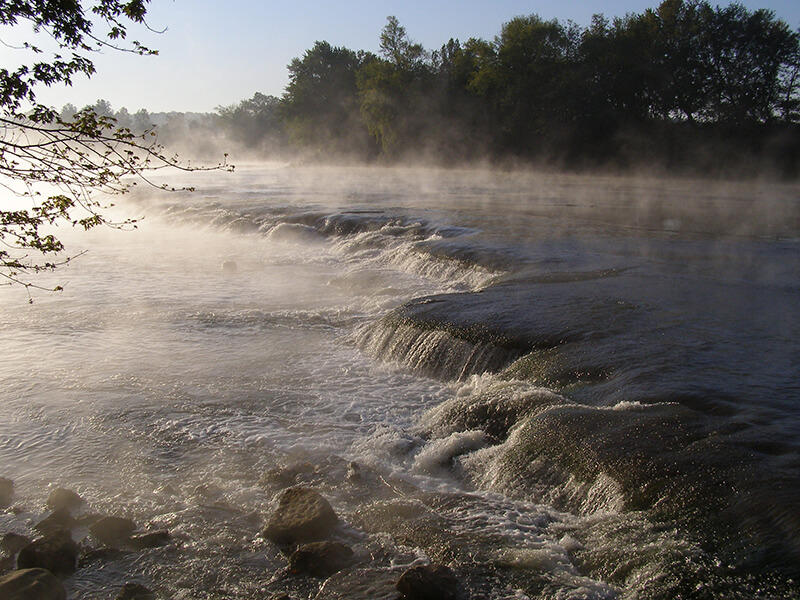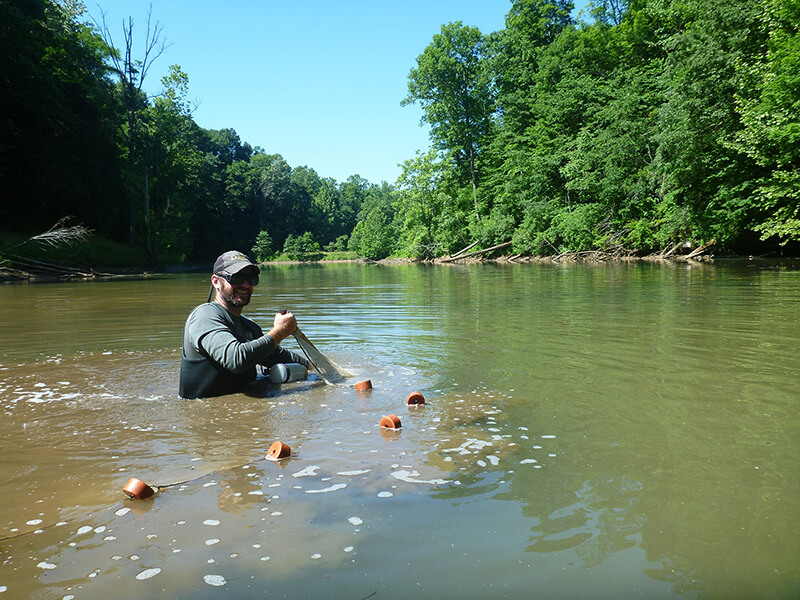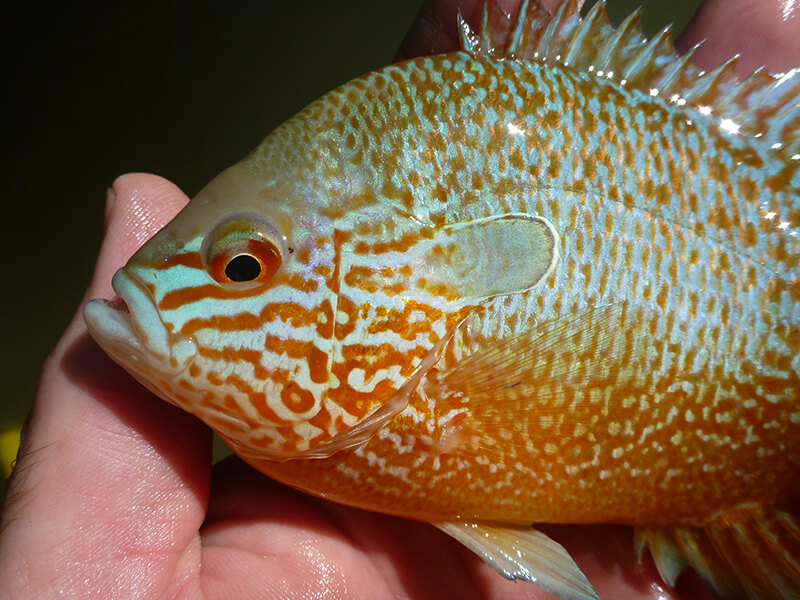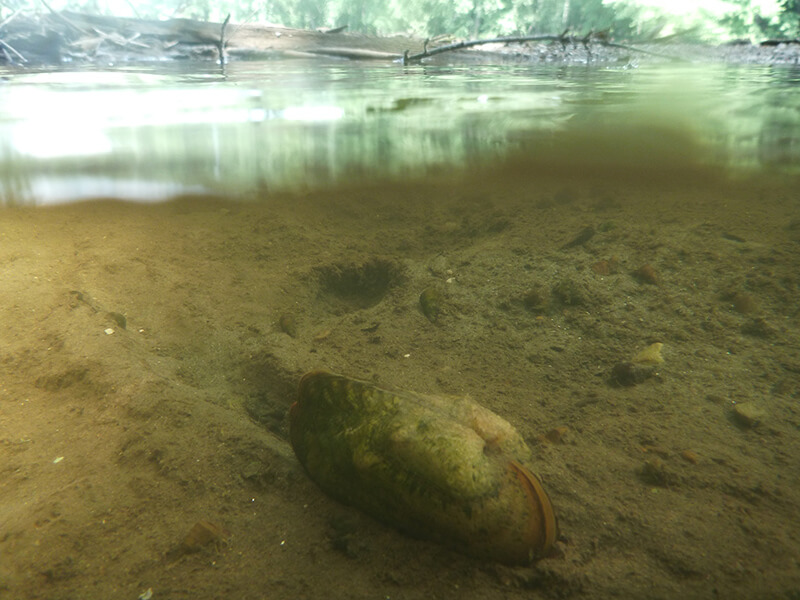Select image to enlarge and view caption.
Fish and freshwater mussels
Fish and freshwater mussels can be found in every permanent type and size of water body in the state. Even floodplain ponds and wetlands and intermittent streams can become surprisingly full of a rich diversity of fish and some species of freshwater mussels if they can maintain water for several consecutive years. The diversity of fish and freshwater mussels that might inhabit a certain water body can be affected by size, location in the state, diversity of habitats, past and present water quality or habitat disturbances, non-native species impacts, and impediments to dispersal within the watershed, among other factors. While aquatic species are not always as easily observed as terrestrial species, Indiana waters contain an amazing diversity of them.
Indiana’s aquatic habitats are currently home to about 200 species of fish and 60 species of freshwater mussels. While many are common and distributed throughout much of the state, several species are rare and restricted to a single stream, lake, or watershed. Twenty-two species of fish and 25 species of freshwater mussels are listed as a Species of Greatest Conservation Need (SGCN) by the Indiana DNR.
Habitat management and conservation programs for these species are supported through the generosity of Hoosiers who donate to the Indiana Nongame Wildlife Fund. No state tax dollars are used to manage these species. Consider donating today.
Monitoring Fish and Freshwater Mussel Populations
Indiana DNR nongame aquatic biologists conduct research and monitoring to better understand the status and distribution of Indiana’s fish and freshwater mussel species. Some monitoring is more general and exploratory in nature and may employ a wide range of techniques to sample areas of the state where fish and freshwater mussel information is lacking. Other activities are more targeted toward SGCN and may involve very specialized techniques. SGCN currently being studied and monitored include lake sturgeon, longnose dace, pugnose shiner, trout-perch, western sand darter, channel darter, and all mussel species.
- Monitoring Lake Sturgeon
Indiana’s East Fork White River contains the last remaining native population of lake sturgeon in the Ohio River drainage. Nongame aquatic biologists have been monitoring this population since 1996. During this time, more than 100 individual fish have been captured and tagged, and about 40 of them have been tracked for varying lengths of time using radio telemetry techniques. Lake sturgeon is listed as an endangered species by the Indiana DNR and it is currently under review for federal listing by the U.S. Fish & Wildlife Service.
2023 Highlights
Annual Lake Sturgeon monitoring was completed in October in the East Fork White River. Three locations were netted (using gill and trammel nets) and seven individuals were collected, with all being recaptures. Transmitters were attached to three fish – which brings the total to eight fish at large with transmitters. One netted fish was originally caught and tagged on in 1999 and has now been collected for the seventh time at the exact same location on the river. In 24 years, it has only grown 120mm. This is not uncommon among EF White River Lake Sturgeon, as they all seem to hit a ‘maximum’ size at some point in their life. Weights can fluctuate widely depending on if it is a female that just spawned the previous spring, or one that is ready to spawn the upcoming spring. Our females likely spawn every other year, based on our tracking data:
- 11/10/99 – 55 pounds – 1480mm FL (Fork Length)
- 7/26/00 – 70 pounds – 1500mm FL
- 8/28/01 – 63 pounds – 1495mm FL
- 11/13/07 – 74 pounds – 1551mm FL
- 9/23/11 – 65 pounds – 1580mm FL
- 10/17/13 – 62 pounds – 1576mm FL
- 10/26/23 – 72 pounds – 1600mm FL
A second fish was caught for the third time:
- 8/25/04 – 19 pounds – 1000mm FL
- 11/13/07 – 31 pounds – 1169mm FL
- 10/26/23 – 49 pounds – 1346mm FL
- Statewide Fish Monitoring
Indiana DNR nongame aquatic biologists conduct general surveys for fish throughout the state on an annual basis. A variety of methods including electrofishing and/or seining, trawling, gill/trammel netting, dip-netting, and other methods are used to collect all fish species inhabiting the sampled stretch of river, stream, lake, or other aquatic habitat. This helps biologists find SGCN in locations where they were previously unknown, detect declines in species that may need to be considered for listing, and gather information on fish species that are unlisted but are important host species for mussel reproduction.
2023 Highlights
- General fish sampling was completed in April in the Little Vermilion River and Jonathan Creek in Vermillion County. Bigeye Shiner (Notropis boops) was collected from the Little Vermilion River at one location, confirming that the species is still present in the drainage in Indiana and the first collection since Shelby Gerking in the 1940s. The Little Vermilion River is the only western-entering Wabash River tributary that Bigeye Shiner is currently known to occur in the state.
- Kolb Ditch (slough) at Angel Mounds State Historic Site in Vanderburgh County was sampled in May, specifically for Banded Pygmy Sunfish (Elassoma zonatum), but none were found. Robust Flier (Centrarchus macropterus) populations were encountered. It was the most abundant sunfish by far, with several year classes represented, including very small (<23mm) young-of-the-year individuals. Some juvenile Lesser Siren (Siren intermedia) and several Copper-bellied Watersnakes (Nerodia erythrogaster neglecta) were also collected/observed.
- More general fish sampling was completed in September in Sugar Creek, Parke County. Tippecanoe Darter (Etheostoma tippecanoe), Streamline Chub (Erimystax dissimilis), and Silver Shiner (Notropis photogenis) were all collected for the first time ever from the watershed, while Bluebreast Darter (Etheostoma camurum) was collected for the first time since the 1970s. Sugar Creek now represents the most downstream tributary on the Wabash River to have Tippecanoe Darter, Streamline Chub, and Bluebreast Darter.
- Some boat electrofishing on the Pigeon River, LaGrange County, was completed in September to look for the state endangered Greater Redhorse (Moxostoma valenciennesi). An angler had submitted a photo last year of one caught in the stretch between the Mongo and Nasby dams. We did verify its presence in this stretch with the collection of one large adult, but sampling in the next pool downstream between the Ontario and Nasby dams yielded none, although robust populations of other redhorse species were present. Further investigation will be required to fully understand the population in the basin. A total of 39 fish species were documented from the areas sampled.
- Sampling for Banded Pygmy Sunfish (Elassoma zonatum) was completed in November in the Evansville area, Vanderburgh County, at two sites in Howell Wetlands (Oxbow Lake and Bald Cypress Basin), an unnamed wetland along Carpentier Creek, and Eagle Slough. Banded Pygmies were collected from Oxbow Lake and the unnamed wetland, which now represents the most eastern population known from the state.
- Statewide Mussel Monitoring
Indiana DNR nongame aquatic biologists conduct general surveys for freshwater mussels throughout the state on an annual basis. Surveys are normally conducted using a timed search approach. This approach takes a section of a stream that is visually (if possible) and physically (such as searching through the stream bottom with shoed-feet, hands, or specialized rakes) searched for live mussels and other shell material while recording the amount of time that is exerted.
2023 Highlights
- General mussel sampling was completed in June in Richland Creek, Greene County. Robust populations of Threeridge (Amblema plicata) were found, along with some live Kidneyshell (Ptychobranchus fasciolaris), Spike (Eurynia dilatata), Rainbow (Villosa iris), and Little Spectaclecase (Leaunio lienosa), all species of Special Concern.
- More general mussel sampling was completed in June in Laughery Creek (Ripley, Ohio, and Dearborn). Some large mussel populations were encountered, with one highlight being the collection of two fresh dead juvenile Kidneyshell (Ptychobranchus fasciolaris) specimens, a species of Special Concern. While no living specimens were encountered, the collection of juveniles indicates at least some level of recent reproduction has occurred in the system. A single weathered dead Salamander Mussel (Simpsonaias ambigua) shell was also collected. This was a rare find, as the shells are small, fragile, don’t last long in the environment, and are usually under large rocks. Salamander Mussel is proposed state endangered and was recently listed as federal endangered.
- General mussel sampling was completed in July in the Salamonie River, Wabash County, downstream from the reservoir. A shell (both valves) of Salamander Mussel was found at one site, which is a decent expansion of the known range for this species in Indiana, although it shows up in some disjoined locations around the state. Its only host for reproduction is the Mudpuppy, and to date, there are no known observations for Mudpuppy from Wabash County. A few old living individuals were also found for a handful of species, including Wavyrayed Lampmussel (Lampsilis fasciola) and Black Sandshell (Ligumia recta), both Special Concern species.
- More general mussel sampling was completed in August in Willow Creek (Noble), Bilger Ditch (Noble), Sycamore Creek (Noble), Rimmell Branch (Noble), Croft Ditch (Noble), Diehl Ditch (DeKalb), Leins Ditch (DeKalb), Metcalf Ditch (DeKalb), Sol Shank Ditch (DeKalb), and Bear Creek (DeKalb). A lot of these sites were very steep, banked ditches, that are maintained regularly, and had minimal flow/habitat. A single live Slippershell Mussel (Alasmidonta viridis), a state species of Special Concern, was collected from Bilger Ditch, which would represent a new population in the Lake Erie drainage, as live individuals had only been found from the upper parts of Fish Creek in the past.
- Mussel relocation was completed in September in Graham Creek, Jennings County, at the C.R. 800 S. bridge replacement project. Mussels were collected and relocated upstream from under the old bridge that was later demolished. A total of 69 individuals of 12 species were collected, including three Special Concern species – Little Spectaclecase (Leaunio lienosa), Rainbow (Cambarunio iris), and Spike (Eurynia dilatata). A portion of the mussels were marked and will be monitored for survival post-relocation.





